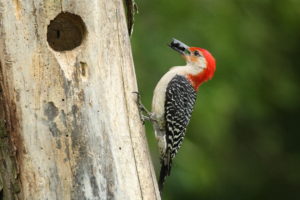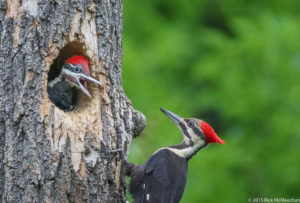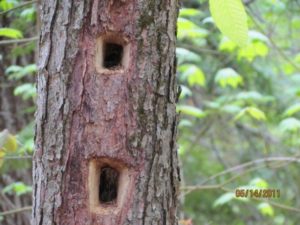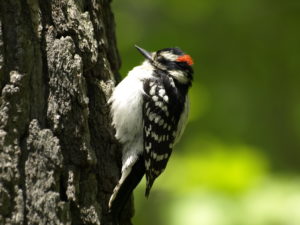Rat-a-tat-tat, rat-a-tat-tat.
No, that drumming isn’t somebody at your door, nor is it a construction worker outside your window.
It’s a friendly woodpecker!
If you spot one of these boisterous birds, it’s a good indication that the environment around you is in great shape. In Cuyahoga Valley National Park, you can find a variety of woodpeckers. Follow our woodpecker guide and keep a lookout for these most commonly found woodpeckers on your next hike!
There are more than 180 species of woodpeckers worldwide, but some of the most common ones you’ll find in Cuyahoga Valley National Park are the red-bellied woodpecker, downy woodpecker, and the pileated woodpecker.

Ed Toerek
Red-belied woodpecker The red-belied woodpecker is the most abundant woodpecker in CVNP. Don’t let its name fool you — although it’s named the red-belied, the most prominent part of this bird’s plumage is actually on its red head.
Where to find them: You can find red-bellied woodpeckers in the woodlands and forest along branches and trunks of medium to large trees, from oak trees to pines trees. You might also find them at your backyard bird feeder if they choose to venture away from the forest.
Did you know? Most woodpeckers have zygodactyl feet, which means they have two toes facing the front and two toes facing the back to help them strongly grip trees and poles in a vertical position. They use those toes with their stiff tail feathers to brace on trees as they climb. Woodpeckers also have longer and thicker talons than other birds, which helps them have an exceptional grip.

Rick McMeechan
Pileated Woodpecker The pileated woodpecker is one of the biggest in North America — about the size of a crow. It is black with bold white stripes going down its neck, and a bright red crest. The pileated woodpecker’s hammering is powerful, carrying a long distance throughout the woods. They drum to attract mates and to establish the boundaries of their territory.
Where to find them: Have you ever been in the woods in CVNP and found these odd holes in trees? You just found the “take-out” joint for pileated woodpeckers. They whack holes in dead standing trees and fallen logs looking for their main prey, carpenter ants, burrowing in the decaying wood. Specifically, these woodpeckers can be seen or heard in the Brandywine gorge area, as well as in the Old Carriage Trail area.

Did you know? A woodpecker’s tongue is up to 4 inches long depending on the species, and many of them are barbed to help the birds extract bugs from trees and holes.

Sue Simenc
Downy Woodpecker The downy woodpecker is the smallest of them all. They have a straight, chisel-like bill, blocky head, wide shoulders, and straight-backed posture. They are mainly black on the upperparts and wings, with a white back, throat and belly and white spotting on the wings.
Where to find them: You’ll find Downy Woodpeckers in open woodlands, particularly among deciduous trees, and brushy or weedy edges. They’re also at home in orchards, backyards and vacant lots.





